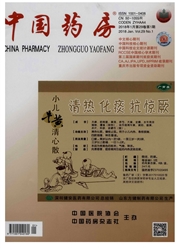

 中文摘要:
中文摘要:
目的:考察人参皂苷Rg。配伍乌头碱对体外培养心衰模型心肌细胞的保护作用。方法:将新生大鼠心肌细胞分为正常对照组、模型组、阳性对照组(去乙酰毛花苷注射液,1×10^-7mol/L)、人参皂苷l沁,组(1×10^-8mol/L)、乌头碱组(1×10^-9mol/L)以及人参皂苷Rg1与乌头碱不同配比的配伍组(1:1、2:1、1:2,V/V)。除正常对照组外,其余各组细胞均以O.8%戊巴比妥钠诱导心肌细胞心衰模型。成模后,各组细胞给予相应药物培养1h,然后检测细胞总三磷酸腺苷(ATP)酶、Ca^2+-Mg^2+.ATP酶和Na^+ -K^+ -ATP酶活力;检测细胞培养液中酸性磷酸酶(ACP)、乳酸脱氢酶(LDH)活力和脑钠肽(BNP)、肿瘤坏死因子α(TNF-α)含量以及细胞中总糖原含量。结果:与正常对照组比较,模型组细胞总ATP酶和Ca^2+ -Mg^2+ -ATP酶活力明显降低,Na^+ -K^+ -ATP酶活力明显升高,培养液中ACP、LDH活力及BNP含量均明显升高(P〈O.05)。与模型组比较,各给药组细胞总ATP酶活力显著升高,细胞培养液中LDH活力显著降低,且以人参皂苷Rg。与乌头碱2:1配伍时作用最强;乌头碱组和各配伍组细胞Na^+ -K^+-ATP酶活力均显著降低,差异均有统计学意义(P〈0.05);各给药组细胞培养液中ACP、BNP活力均有降低的趋势,细胞内总糖原含量和培养液中TNF-α含量无显著变化(P〉O.05)。结论:人参皂苷Rg1配伍乌头碱可改善大鼠心衰模型心肌细胞ATP酶活力和膜通透性,调节细胞分泌BNP,对心衰模型心肌细胞有一定保护作用,且以人参皂苷Rg1与乌头碱2:1配伍时作用最强。
 英文摘要:
英文摘要:
OBJECTIVE: To investigate the protective effect of the compatibilities of ginsenosides Rg1 and aconitine on myocar- dial cell of in vitro cultured heart failure model. METHODS: The myocardial cells of neonate rat were grouped into normal control group, model group, positive control group (Deslanoside injection, 1×10-7 mol/L), ginsenosides Rg1 group (1×10-8 mol/L), acon- itine group (1 × 10-9 mol/L) or their compatibilities groups (1 : 1,2 : 1,1 : 2, V/V). Except for normal control group, other groups were given 0.8% pentobarbital sodium to induce heart failure model of myocardial cells. After modeling, each group was given rele- vant medicine for 1 h, and then the activities of T-ATPase, Ca2+-Mg2+-ATPase, Na+-K+-ATPase in cells were all detected. The activi- ties of acyl carrier protein (ACP) and lactate dehydrogenase (LDH), and the contents of brain natriuretic party(BNP), TNF-α and total glycogen were measured in cell culture fluid. RESULTS: Compared with normal control group, T-ATPase and Ca2+-Mg2+-ATPase activities were decreased significantly in model group; meanwhile, Na+-K+-ATPase activity was increased signifi- cantly, and ACP, LDH activities and BNP content in cell culture fluid were increased significantly (P〈0.05). Compared with mod- el group, the activities of T-ATPase in treatment groups were increased significantly, while the activity of LDH in cell culture fluid was decreased significantly; when the volume ratio of ginsenoside Rgl to aconitine was 2 : 1, protective effect was the strongest; the activities of Na+-K+-ATPase in aconitine group and compatibility groups were all decreased significantly, with statistical signifi- cance (P〈0.05). The activities of ACP and BNP in cell culture fluid were all decreased in treatment groups, but the content of to- tal glycogen in cells and the TNF-α content of in cell culture fluid had no change (P〉0.05). CONCLUSIONS: Compatibility of ginsenosides Rg1 and aconitine can impro
 同期刊论文项目
同期刊论文项目
 同项目期刊论文
同项目期刊论文
 期刊信息
期刊信息
